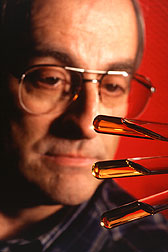Natural Plant Extracts Might Sub for Methyl Bromide
|
|
Essence of peach sounds like a perfume or flavoring.
It is, actually. But the scientific name for this colorless, nontoxic, aromatic liquid found in essential oils of peach seeds is "benzaldehyde." Many such volatile oils, like lemon, cinnamon, and peppermint, are extracted and distilled from plants. Naturally occurring benzaldehyde is used commercially in perfumes, flavorings, pharmaceuticals, and dyes.
But Charles L. Wilson, a plant pathologist at the ARS Appalachian Fruit Research Station in Kearneysville, West Virginia, has found a potential new use for this compound. He has been testing benzaldehyde and other natural plant volatiles as possible alternatives to methyl bromide fumigation.
The research is collaborative with scientists from the Volcani Center in Bet Dagan, Israel, and the INFRUTEC Center for Fruit Technology at the Fruit, Vine, and Wine Research Institute of the Agricultural Research Council in Stellenbosch, South Africa.
Methyl bromide is critical to agriculture worldwide as a soil fumigant, postharvest storage protectant, and quarantine treatment to control many pests on various crops. The primary use for this chemical is to fumigate soil to destroy soilborne pests. However, the escape of some of the fumigant from the soil into the atmosphere has led to its being declared an ozone depletor. So, under the U.S. Clean Air Act, production and importation of methyl bromide will be banned in the United States in 2005.
"For several years now, we've been diligently searching for practical and effective alternatives to methyl bromide," says ARS administrator Floyd P. Horn. "This fumigant is used on more than 100 crops. And differences in soil types, weather, importing country requirements, and many other factors complicate the issue."
"Our collaboration with industry, universities, state agencies, and international organizations is vitally important to our search," Horn says. "This joint work with Israel and South Africa could lead not only to viable alternatives to methyl bromide, but to jointly patented commercial products as well."
In lab studies at Kearneysville, Wilson and colleagues have found several natural plant volatiles that have fungicidal properties.
"We protected fruit against postharvest decay with these compounds," says Wilson. "We found one—benzaldehyde—to be particularly effective. Then we went a step further and used benzaldehyde to fumigate soil and found it very effective against several soil pathogens."
This work is collaborative with Deborah R. Fravel, a plant pathologist with the ARS Biocontrol of Plant Diseases Laboratory in Beltsville, Maryland. Wilson and another associate, Jose Solar, have applied for a patent on a time-release formula of benzaldehyde to fumigate fruit, grain, and soil.
"Since it is inexpensive, easily biodegradable, and breaks down into products that aren't harmful to humans, animals, or the environment, benzaldehyde would be a desirable alternative to methyl bromide as a soil fumigant," Wilson says.
He and Fravel found that soil fumigated with benzaldehyde initially had significantly lower pH values. However, within 2 weeks, the pH returned to previous, nonfumigated, levels. Says Wilson, "This showed that the changes in soil pH are readily reversed and should not interfere with crop production."
Wilson and colleagues have found several natural plant volatiles that are effective against soilborne pathogens such as Fusarium oxysporum, Rhizoctonia solani, Pythium aphanidermatum, and Sclerotinia minor.
To find potential alternatives to methyl bromide, more research is needed on the destructive, or biocidal, activity of natural plant compounds against a wide range of pathogens, insects, and weeds.
A Quick, Easy Test for Fumigants
In addition to comparing the efficacy of natural fumigants in different soil types and different applications, scientists will need to evaluate delivery systems, Wilson says.
"The first order of business is to find, in the lab, the compound or combination of compounds that will control soilborne pests and diseases," he explains. "Then, we'll need to test these in soil and eventually begin field tests to complete the research. We already have several interested companies."
It is difficult to evaluate the effectiveness of fumigants on soil in planting beds or greenhouse containers.
To test a fumigant's effectiveness, large volumes of soil must be fumigated, and elaborate evaluation procedures need to be devised. With the help of Fravel, Wilson built an apparatus to quickly and easily test soil fumigants against soil pathogens.
"Simple to use, this equipment allows the soil to retain uniform amounts of a fumigant for a definite period. Once the soil is fumigated, it can be tested for pathogen activity," Wilson reports.
Wilson and Fravel successfully used it to evaluate the effectiveness of benzaldehyde and nitrogen against soil pathogens.
Partnering Up To Find Alternatives
|
|
Eli Shaaya, who is with the Department of Stored Products at the Volcani Center, works closely with Wilson on the search for natural compounds that might replace methyl bromide.
He and colleagues have identified several essential oils extracted from herb and spice plants that have proven effective as fumigants. They have used these extracts to control the most common stored-product insects—the rice weevil, lesser grain borer, sawtoothed grain beetle, and red flour beetle.
Shaaya also found that several of the essential oils were active against cut-flower insects, including the whitefly.
Wilson has also been working with Johan Combrink of INFRUTEC. Essential oils from indigenous South African plants are now being marketed as flavor and fragrance compounds.
"These oils could also provide a rich source of new compounds that may fumigate soil, agricultural commodities, and physical structures," Wilson says.
Combrink and colleagues are seeking natural plant compounds that fight Botrytis cinerea, Penicillium expansum, Mucor piriformis, and Rhizopus nigricans—pathogens that attack pome fruit, such as apples. They are now controlled with chemicals.
When the research project gets in full swing in South Africa, Combrink and colleagues plan to test natural compounds on controlling weevils, the dried fruit moth, and mites on dried fruit. They'll also investigate controlling the root-knot nematode—a worldwide pest and one of the most significant nematode pests—on a wide range of crops, including stone fruits and vegetables. They will also test natural compounds on the ring nematode, a serious pest of stone fruit and peach orchards not only in South Africa, but in Georgia and South Carolina as well.
In addition, they will fumigate with new natural compounds to control Fusarium wilt on melons, root rot on strawberries, Phytophthora root rot on citrus, replant syndrome on apples, clubroot on cabbage, and damping-off on vegetable crops.
Two South African companies, Ulimocor and the Ciskei Agricultural Corporation, are interested in this research, as is the Maktishim Chemical Company in Israel. Wilson has also been talking with a couple of U.S. companies about research results.
A Reprieve for Methyl Bromide
Legislation passed with the FY 1999 Agriculture Appropriations Bill delays the ban on methyl bromide because U.S. growers have very few viable alternatives to this heavily relied-on chemical. The new legislation ensures that regulations governing U.S. use, production, import, or export of methyl bromide are no more stringent or restrictive than those required by the Montreal Protocol. Instead of the earlier January 1, 2001, target cutoff date, U.S. growers may now use methyl bromide until 2005.
"This reprieve makes our research even more critical, Wilson says. It gives us a little more time to find and test more natural compounds that may replace methyl bromide." —By Doris Stanley Lowe, Agricultural Research Service Information Staff.
This research is part of Methyl Bromide Alternatives, an ARS National Program described on the World Wide Web at http://www.nps.ars.usda.gov/programs/cppvs.htm.
Charles L. Wilson is at the USDA-ARS Appalachian Fruit Research Station, 45 Wiltshire Rd., Kearneysville, WV 25430-9425; phone (304) 725-3451, X330, fax (304) 728-2340.
"Natural Plant Extracts Might Sub for Methyl Bromide" was published in the March 1999 issue of Agricultural Research magazine.








